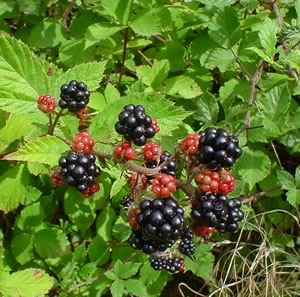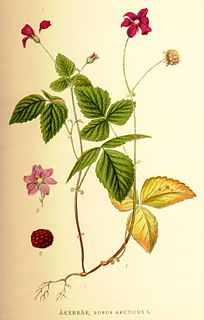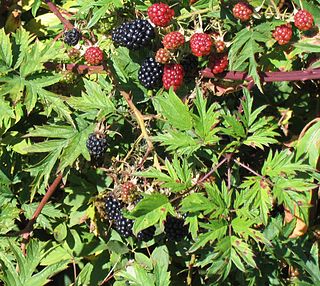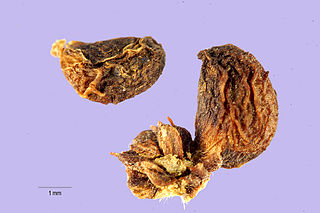
Rubus is a large and diverse genus of flowering plants in the rose family, Rosaceae, subfamily Rosoideae, with 250–700 species.

Rubus caesius is a Eurasian species of dewberry, known as the European dewberry. Like other dewberries, it is a species of flowering plant in the rose family, related to the blackberry. It is widely distributed across much of Europe and Asia from Ireland and Portugal as far east as Xinjiang Province in western China. It has also become sparingly naturalized in scattered locations in Argentina, Canada, and the United States.

Rubus arcticus, the Arctic bramble or Arctic raspberry, is a species of slow-growing bramble belonging to the rose family, found in arctic and alpine regions in the Northern Hemisphere.

Rubus saxatilis, or stone bramble, is a species of bramble widespread across Europe and Asia from Iceland and Spain east as far as China. It has also been found in Greenland.

Rubus laciniatus, the cutleaf evergreen blackberry or evergreen blackberry, is a species of Rubus, native to Eurasia. It is an introduced species in Australia and North America. It has become a weed and invasive species in forested habitats in the United States and Canada, particularly in the Northeast and along the Pacific Coast.

Rubus parvifolius, called Japanese bramble, or Australian raspberry in the United States or native raspberry in Australia is a species of plant in the rose family. It is a scrambling shrub native to eastern Asia and Australia. It has also become naturalized in a few scattered locations in the United States.

Rubus ulmifolius is a species of wild blackberry known by the English common name elmleaf blackberry or thornless blackberry and the Spanish common name zarzamora. It is native to Europe and North Africa, and has also become naturalized in parts of the United States, Australia, and southern South America.

Rubus allegheniensis is a species of bramble, known as Allegheny blackberry and simply as common blackberry. Like other blackberries, it is a species of flowering plant in the rose family. It is very common in eastern and central North America. It is also naturalized in a few locations in California and British Columbia.

Rubus vestitus is a European species of brambles in the rose family, called European blackberry in the United States. It is native to Europe and naturalized along the northern Pacific Coast of the United States and Canada.
Rubus alumnus, the oldfield blackberry, is a North American species of flowering plant in the rose family. It is native to eastern and central Canada and the eastern and central United States.
Rubus frondosus is a North American species of flowering plant in the rose family. It has been found in Ontario and in the eastern and central United States from Maine south to Georgia and west as far as Oklahoma, Nebraska, and Minnesota. Common name is leafy-bracted blackberry.
Rubus geniculatus is a European species of flowering plant in the rose family, with a few naturalized populations in the state of Virginia in the eastern United States. It has compound leaves with 3 or 5 leaflets, green on the upper side, pale green almost white on the lower side. Flowers are white. Fruits are dark purple, almost black.
Rubus kennedyanus is a rare North American species of brambles in the rose family. It is found in eastern Canada and in the north-central United States.
Rubus roribaccus a North American species of brambles in the rose family, called the Lucretia blackberry. It grows in eastern Canada (Québec) and the eastern and central United States.
Rubus tomentosus is a European and Middle Eastern species of brambles in the rose family. It grows in southern and central Europe and in southwestern Asia from Portugal to Iran, north as far as Germany, Poland, and Ukraine. There are a few reports of the species sparingly naturalized in the State of West Virginia in the eastern United States.

Rubus macrophyllus is a European species of bramble in the rose family. It can be found across Europe, from Ireland to Bulgaria. There are reports of the species having become naturalized in the States of Washington and Oregon in the northwestern United States.
Rubus longii is an uncommon North American species of brambles in the rose family. It grows in the eastern United States from Long Island to North Carolina.
Rubus steelei is an uncommon North American species of brambles in the rose family. It grows only in the United States, primarily in the upper Mississippi Valley, the Great Lakes region and the Appalachian Mountains, with isolated populations scattered in Texas, Georgia, and Alabama.
Rubus leviculus is a rare North American species of brambles in the rose family. It has been found only in scattered locations in the eastern and central United States.
Rubus meracus is an uncommon North American species of brambles in the rose family. It grows in the central United States, in the central Mississippi and Ohio Valleys and the Great Lakes region.










